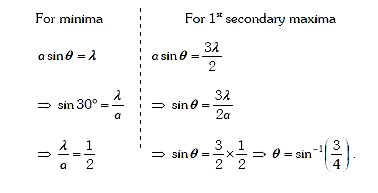In a Fraunhofer diffraction at single slit of width d with incident light of wavelength 5500 Ã…, the first minimum is observed, at angle 30∘. The first secondary maximum is observed at an angle θ=
sin−1(1√2)
sin−1(14)
sin−1(34)
sin−1(√32)
The correct Answer is:C
Topper's Solved these Questions
- BOOK - ERRORLESSCHAPTER - WAVE OPTICS AND ELECTROMAGNETIC THEORYEXERCISE - ASSERTION & REASON27videos
WAVE OPTICS AND ELECTROMAGNETIC THEORY
- BOOK - ERRORLESSCHAPTER - WAVE OPTICS AND ELECTROMAGNETIC THEORYEXERCISE - NCERT BASED QUESTIONS (EM Waves )40videos
WAVE OPTICS AND ELECTROMAGNETIC THEORY
- BOOK - ERRORLESSCHAPTER - RAY OPTICSEXERCISE - Assertion & Reason30videos
RAY OPTICS
Similar Questions
A slit of width a illuminated by red light of wavelength 6500Å. The first minimum will fall at θ=30∘ if a is
View SolutionIn a diffraction pattern due to a single slit of width 'a', the first minimum is observed at an angle 30° when light of wavelength 5000 Å is incident on the slit. The first secondary maximum is observed at an angle of:
View Solution
Knowledge Check
- Question 1 - Select One
In a Fraunhofer diffraction at single slit of width d with incident light of wavelength 5500Å, the first minimum is observed, at angle 30∘. The first secondary maximum is observed at an angle θ =
Asin−1(1)√2Bsin−1(1)4Csin−1(3)4Dsin−1(√3)2 - Question 2 - Select One
In a Fraunhoffer diffraction at single slit of width 'a' with incident light of wavlength of 5500 Å, the first minimum is observed, at an angle of 30∘. At what angle the first secondary maximum is observed?
Asin−11√2Bsin−114Csin−134Dsin−1(√3)2 - Question 3 - Select One
In a Fraunhofer diffraction experiment at a single slit using a light of wavelength 400 nm, the first minimum is formed at an angle of 30∘. The direction θ of the first secondary maximum is given by :
Asin−1(23)Bsin−1(34)Csin−1(14)Dsin−1(23)
In a diffraction pattern due to a single slit of width 'a' the first minimum is observed at an angle 30 when light of wavelength 5000Å is incident on the slit. The first secodary maximum is observed at an angle of :
View SolutionIn a diffraction pattern due to a single slit of width a, the first minimum is observed at an angle 30∘ when light of wavelength 5000 Å is incident on the slit. The first secondary minimum is observed at an angle of
View SolutionIn a diffraction pattern due to a single slit of width a, the firt minimum is observed at an angle 30∘ when light of wavelength 5000 Å is incident on the slit. The first secondary miximum is observed at an angle of
View SolutionIn the diffraction pattern due to a single slit of width 'd' with incident light of wavelength 'λ', at an angle of diffraction 'θ', the condition for first minimum is
View SolutionIn the experiment of diffraction at a single slit, if the slit width is decreased, the wdith of the central maximum
View Solution


